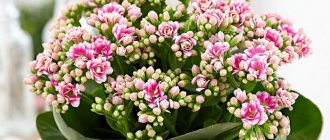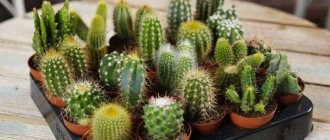Author: Tamara Altova. September 24, 2017
Category: Houseplants.
Kalanchoe, or Kalanchoe (lat. Kalanchoe) is a genus of succulents of the Crassulaceae family, which includes more than two hundred species growing in the tropics of South America, tropical Africa, Madagascar, Southeast and South Asia. Some of the types of Kalanchoe are popular indoor plants that are grown not only for their decorative purposes, but also for medicinal purposes.
Kalanchoe care briefly, table
Kalanchoe is a popular indoor flower. Many varieties of this perennial bloom profusely and are distinguished by a variety of bud colors.
Achieving flowering can be quite simple, because Kalanchoe is famous for its low maintenance requirements. The main thing is to follow the simple rules that you will find in the table below.
| Type of care | How to care |
| Watering | The culture needs moderate watering. It is necessary to water at the root as the top layer of soil dries. Watering should not be frequent, as Kalanchoe tolerates drought well. |
| Illumination | Needs bright, indirect light |
| Temperature | In summer, you need to maintain a temperature regime of 18-22 degrees. In winter, the temperature drops to 15-16 degrees. To stimulate flowering, Kalanchoe should be moved to a cool and dark place for a couple of weeks to form flower buds. |
| Feeding | It responds well to fertilization every 10 days during the active growing season. It is recommended to choose complex nutrients. |
| Trimming | It is recommended to trim off faded buds. Regular decorative pruning is also recommended to give the plant a neat shape. The cut parts can be rooted. |
| Air humidity | Grows equally well at almost any air humidity |
In order for Kalanchoe to regularly form buds and bloom profusely, it is recommended to transplant it into a new substrate once a year at the initial stage of cultivation.
NOTE! Kalanchoe has a number of beneficial properties. Kalanchoe Degremona leaves have antimicrobial and anti-inflammatory properties and are used to combat runny nose and colds.
Appearance
Varieties of Kalanchoe share several main external characteristics:
- the root system is fibrous, with a short and branched rhizome; the roots are located in the upper part of the soil;
- dense, succulent stems are abundantly covered with foliage;
- the shape of the leaves varies depending on the type of succulent: oval, jagged, heart-shaped, narrow or lobed;
- the leaves are fleshy, rich green, less often dark purple;
- flowers are united in paniculate inflorescences, about 10 specimens in each inflorescence;
- the tree of life blooms with buds of yellow, red, white, purple or orange; flowers four-membered, erect or drooping;
- bears fruit with multi-seeded leaflets.
Most varieties of Kalanchoe grow and develop well under the supervision of plant growers.
How to care for Kalanchoe in a pot after purchase
The variety of Kalanchoe varieties makes it popular for growing in houses and apartments.
It can not only be purchased in specialized flower shops, but also grown from just one leaf taken from a friend.
You need to care for the purchased Kalanchoe as follows.
- To begin with, the flower must be left in quarantine for several days to make sure that it is not sick and there are no pests on it.
- Then the plant is transplanted into a new substrate. The plant in the flower shop is often fed so that it does not lose its presentation. This can negatively affect the root system. Therefore, after purchase, the plant is transplanted into a new nutrient substrate.
- Watering is carried out only after the top layer of soil has dried.
- After purchase, fertilizers are not used during the first 10 days. As mentioned above, the flower in the flower shop was already overfed.
- If you bought Kalanchoe in the summer, then once a week it will be useful to spray it with warm water.
Store-bought flowers very often start to hurt at home. This is due to adaptation: a change of place, a new environment and microclimate. But if you properly care for the plant, the process of getting used to the new growing conditions will go quickly.
Folk signs
By the appearance of deer antlers you can judge the attitude of strangers towards your home. If after the guest leaves the plant begins to wither, it means that the person is hostile to the owners. If the bush is completely destroyed, it is also going to harm you.
It is better not to give this succulent to newlyweds, as the couple will start having quarrels and misunderstandings. And for a married couple with many years of experience living together, a flowerpot with this Kalanchoe will come to the court, strengthening and refreshing the relationship.
Conditions for keeping Kalanchoe
Growing Kalanchoe at home is not difficult if you provide it with suitable maintenance.
Lighting for Kalanchoe
Kalanchoe loves bright but diffused sunlight. If you place it on a south window, you will have to shade it in the summer.
The ideal place for a flower is a south-east window.
In winter, you may need additional lighting with special phytolamps, but this is not at all necessary, especially if your flower will be in a dormant period during the winter months.
Temperature regime for a flower
Kalanchoe in an apartment quickly adapts to changes in temperature. In order for the crop to bloom constantly and luxuriantly, it is advisable to maintain a temperature of 18 - 22 degrees in summer and 15 - 16 in winter.
Air humidity
Although Kalanchoe develops well at almost any air humidity, it still loves high humidity.
Therefore, in summer it is advisable to spray the flower with water, or place a container with liquid on the windowsill.
ON A NOTE. In principle, you can take care of it in the same way in winter, since heating radiators dry out the air greatly. But, in general, Kalanchoe is hardy enough to survive dry air.
Location and where is the best place to put Kalanchoe
Kalanchoe does not have any special preferences for location in an apartment or house.
It is desirable that the flower receives the right amount of light. In summer you can place it on eastern window sills. In winter, Kalanchoe is placed on the sunny south side. This placement allows you to receive the right amount of light.
ON A NOTE. Kalanchoe thrives equally well in the bedroom, family room, living room and kitchen.
Soil for Kalanchoe, what kind of soil is needed
Kalanchoe does not have any special requirements for soil type. The flower feels good in ordinary flower soil.
You can also prepare the substrate yourself.
To do this you will have to perform the following algorithm of actions:
- mix leaf soil and peat in equal proportions;
- add 1 part of coarse river sand;
- heat the resulting mixture in the oven at a temperature of 70 degrees.
An important point is that the soil must have good aeration, that is, it must be saturated with oxygen. In heavy, oily soil, the plant feels worse.
How to choose a flower pot
The size of the pot depends on the size of the root system of a particular specimen. Experts recommend planting in small pots, since Kalanchoe grows quickly and branches heavily. This affects the decorative qualities of the plant. In addition, small specimens look neat and are easier to care for.
Typically, containers 3-4 cm larger than the roots are selected for transplantation. As the root system grows, the Kalanchoe must be replanted again and again.
Description of the plant:
Plant size and type:
Kalanchoe tomentosa is a succulent shrub up to 45 cm high. The dense fleecy covering on the leaves performs the vital function of retaining moisture. In drought conditions, it allows you to save the small amount of water that the plant absorbs from the soil. Villi delay the movement of air at the surface of the leaves, reducing moisture loss through evaporation.
PHOTO: To top it all off, the fuzzy cover protects the leaves from harsh outdoor conditions, and its white-silver color reflects light, reducing the chance of the leaves overheating.
Stem:
The stem is thick, woody, up to 45 cm high.
IN THE PHOTO: In an adult plant, the stem branches and forms numerous rosettes of leaves. Photo by: @debralbaldwin.
Leaves:
The leaves are collected in a loose rosette, they are oval, 3–8 cm long, covered with thin bristly hairs of a silvery color, with the exception of spots along the edges, the hairs on which are rusty-orange in young leaves and chocolate brown in old ones.
Flowers:
In nature, this plant blooms with pubescent, bell-shaped flowers; flowering rarely occurs indoors.
Flowering period:
Spring and summer.
Varieties:
Kalanchoe tomentosa cv. Chocolate Soldier
This variety is distinguished by thinner and longer leaves with a red-brown border along the edges. It grows a little faster than the usual Kalanchoe tomentosa and bushes more strongly.
IN THE PHOTO: Kalanchoe tomentosa cv. Chocolate Soldier.
Caring for Kalanchoe
As mentioned above, Kalanchoe is not at all demanding to care for. It tolerates drought and bright sunlight well, takes root easily and grows quickly.
But, if you want your flower to grow strong, healthy, bloom lushly and regularly, it is better to provide the plant with suitable conditions for growth.
Features of watering Kalanchoe
In summer, Kalanchoe needs frequent watering. It is advisable to water every 3-4 days, since in summer the soil will often dry out. Try to pour water carefully so as not to get on the leaf plates.
In winter, care must be taken differently: watering is reduced to once a week.
IMPORTANT! Settled water is used for irrigation.
More information about watering Kalanchoe
Application of fertilizing and fertilizers
Kalanchoe will also need fertilizers. Especially during the active spring-summer growing season.
It is better to use liquid complex mixtures with equal contents of potassium, nitrogen and phosphorus. You can use specialized mixtures for succulents.
You can adhere to this fertilizer application schedule.
- in summer it is recommended to feed the crop with complex fertilizers every 10 days;
- in spring, the frequency of fertilization is every 15 days;
- in autumn, fertilizing is reduced to 1 time every 20 days;
- In winter you don’t have to feed it, as Kalanchoe goes into a dormant state.
Too intensive feeding during the dormant period can lead to buds starting to form prematurely and the plant becoming weak.
Spraying
A common problem in caring for Kalanchoe is dry air in apartments. This is especially evident in winter, when central heating pipes and radiators literally dry out the room.
Of course, Kalanchoe can grow in the dry microclimate of an apartment, but it is still advisable to maintain a slightly increased level of air humidity around the crop.
Therefore, Kalanchoe is sprayed with water from a spray bottle.
Spraying in summer is carried out once a week. Warm, settled water is used for spraying. This method of moistening also allows you to saturate with moisture and wash away dust from the sheet plates.
In winter, spraying is reduced to 1 time every 2 weeks. It is carried out so that the leaves do not lose their elasticity and rich color.
NOTE! Spraying too frequently can lead to fungal infections.
Trimming
It is important to prune in a timely manner. After the buds fade, you need to carefully trim the flower stalks.
It is also advisable to carry out sanitary pruning, removing damaged shoots.
Since Kalanchoe is a fast-growing crop, in one season the plant grows quite a large green mass. It doesn't always look neat.
Therefore, experienced gardeners recommend regular decorative pruning. In this case, the cut parts of the plant can be rooted and new specimens obtained.
Transplanting Kalanchoe into a new pot
It is recommended to transplant young specimens into a new container every year. For adult bushes, replanting is carried out every 2-3 years.
If the plant is blooming and an emergency transplant is required, you need to carefully transplant the bush into a new container, which will be several centimeters larger than the previous one, using the transfer method.
It is recommended to replant in early spring (March). During the transplantation period, you need to carefully inspect the roots and, if necessary, cut off damaged ones.
Recommendations from experienced plant growers
Some tips for growing Kalanchoe from experienced gardeners:
- You should not put Kalanchoe in a plastic container. Moreover, metal-plastic windows can also negatively affect crop growth. It is not always possible to place the tree of life away from plastic windows. But if this succeeds, the Kalanchoe will thank the grower with abundant flowering and rapid growth.
- The succulent blooms from February to March, but it can also be grown in greenhouses. Then flowering can be achieved at the very beginning of winter. The grower must provide the plant with bright lighting, regular feeding and proper watering.
- If it is not possible to maintain the room temperature above 10 C°, the Kalanchoe needs to be additionally illuminated and warmed with lamps.
Among the numerous varieties of Kalanchoe, there are both decorative and medicinal varieties. This culture is considered hardy and unpretentious in care, which is why plant growers like it so much. Kalanchoe is a plant with powerful energy, gives a person confidence in his abilities and keeps peace in the family.
Reproduction of Kalanchoe at home
The advantage of Kalanchoe is not only that it is easy to care for, but also that the culture is easy to propagate.
Kalanchoe can reproduce in the following ways.
Cuttings
Suitable for all varieties. Propagation by cuttings is carried out according to the following scheme:
- using a scalpel or a sharp knife, cut off a stalk (leaf, piece of stem, etc.);
- Warm water is poured into a small container and a root formation stimulator, for example, Kornevin, is added;
- The cutting is placed in water and left until roots appear. After which it is planted in a pot.
Air children
This method is suitable for propagating Kalanchoe Degremon.
During the growth period, this variety forms airy babies on the edge of the leaf, which periodically fall off.
If they are carefully collected and placed in the soil, after a few weeks you will notice strong shoots that are ready to be grown as individual plants.
Is there any harm
For all its positive properties, Kalanchoe can cause harm. Succulent juice should not be used in the following cases:
- for oncology;
- for liver damage, hepatitis;
- if you are allergic to Kalanchoe juice;
- for joint diseases.
It is necessary to take products based on Kalanchoe juice with the approval of a doctor. Be sure to follow the dosage. Taking too much of the medicine will cause diarrhea or heartburn. When used externally, the juice can damage the skin and mucous membranes.
Caring for Kalanchoe at home at different times of the year
How to care for Kalanchoe depends, among other things, on the time of year.
Spring care
In spring, Kalanchoe needs replanting and rejuvenating pruning. Adult specimens are transplanted into new pots and old shoots are pruned.
It is also recommended to fertilize with complex fertilizers in spring to stimulate growth.
How to care in summer
In the summer, care must be taken mainly by providing regular watering and periodic feeding, since many specimens begin to bloom profusely in the summer.
Flower care in autumn and winter
In the fall, the frequency of watering is reduced and preparations for winter begin.
The frequency and abundance of fertilizing is also reduced. The plant reduces the intensity of flowering and needs additional lighting.
What to do with the flower after flowering?
After the bush fades, it is necessary to help it recover. To do this, first of all, the flower stalks are carefully trimmed.
It is also recommended to fertilize and shade the bush for several days. If you leave it in bright light, new buds will begin to form, which will be small and not very expressive.
Why does Kalanchoe not bloom, how to care for it to bloom
Sometimes there are cases when the plant does not bloom. In order to stimulate flowering, you must perform the following steps:
- extend daylight hours using special lamps;
- trim old faded buds;
- feed the bush with potassium fertilizers.
To obtain flowering, it is necessary to reduce the temperature by 1-2 degrees. However, when lowering the temperature, it is important not to overdo it, otherwise the crop may go dormant. Then you will have to wait even longer for flowering.
Landing
The plant does not like frequent changes of soil, so young and adult specimens are replanted as they grow.
Choosing a pot
For Kalanchoe, a wide and deep pot with drainage holes is suitable. Planting bushes in pots is recommended only for those gardeners who know how to control the amount of liquid at the roots. A drainage layer of brick, pebbles or expanded clay must be poured onto the bottom of the container.
Soil composition
Kalanchoe is undemanding to soil and grows well in universal, commercially available soil mixtures for succulents. You can prepare the soil at home by mixing sand, leaf and turf soil with peat in a ratio of 1:2:4:1.
Transfer
Kalanchoe does not like changing location, so it is replanted only when the roots and stems completely fill the pot. The bush is pre-watered so that the earthen ball does not fall apart during transplantation. Then remove the plant from the pot by holding the base of the stem and transfer it to a new one. Fill the voids with soil mixture and place the pot in its original place. It is better to water the plant on the 5th day after transplantation.
Diseases and pests
It happens that at home, Kalanchoe sometimes gets sick and is attacked by pests.
Aphid
The parasitic insect is dangerous because it sucks the juices out of the plant and can infect it with fungal infections. Aktara, a solution of ammonia, is used for processing.
Spider mite
Its presence can be identified by a small sticky web.
The pest quickly spreads throughout all shoots. To combat it, it is necessary to treat it with Aktara.
Diseases
With proper care, the flower rarely gets sick.
But if you water too often, root rot can occur, which causes the leaves to turn black. To eliminate the problem, you need to reduce the frequency of watering and let the soil dry out. Damaged leaves are cut off.
Beneficial features
Juice is extracted from the fleshy leaves of Kalanchoe. It is used both in home and official medicine. Compresses and lotions from this miraculous remedy help with the following problems:
- non-healing wounds;
- sunburn;
- trophic ulcers;
- boils.
Kalanchoe juice helps with runny nose in children and adults. It is instilled into the nasal passages.
Kalanchoe has the ability to kill harmful microbes that fly in the air. Therefore, it is useful to place a tree of life in every room.











